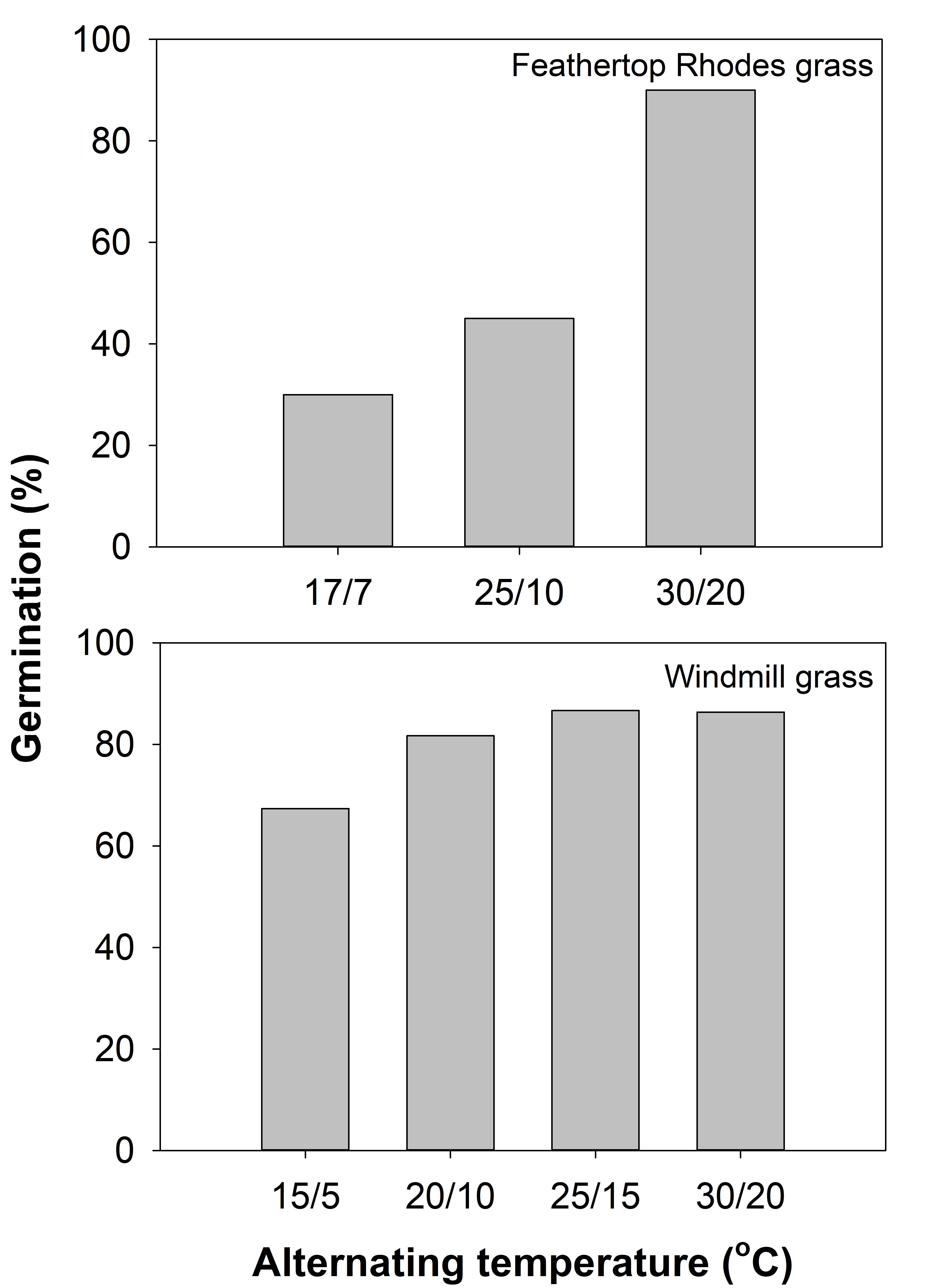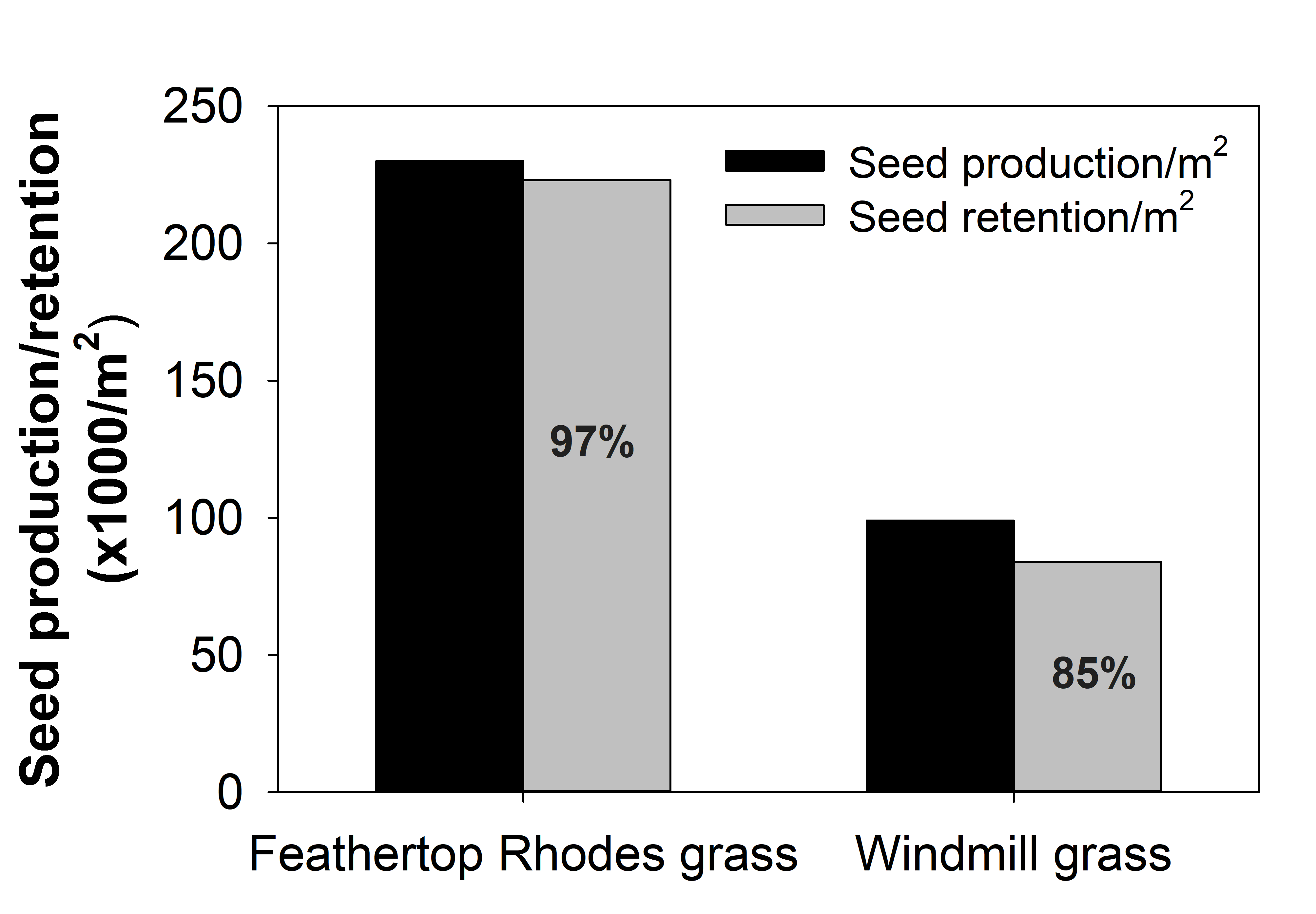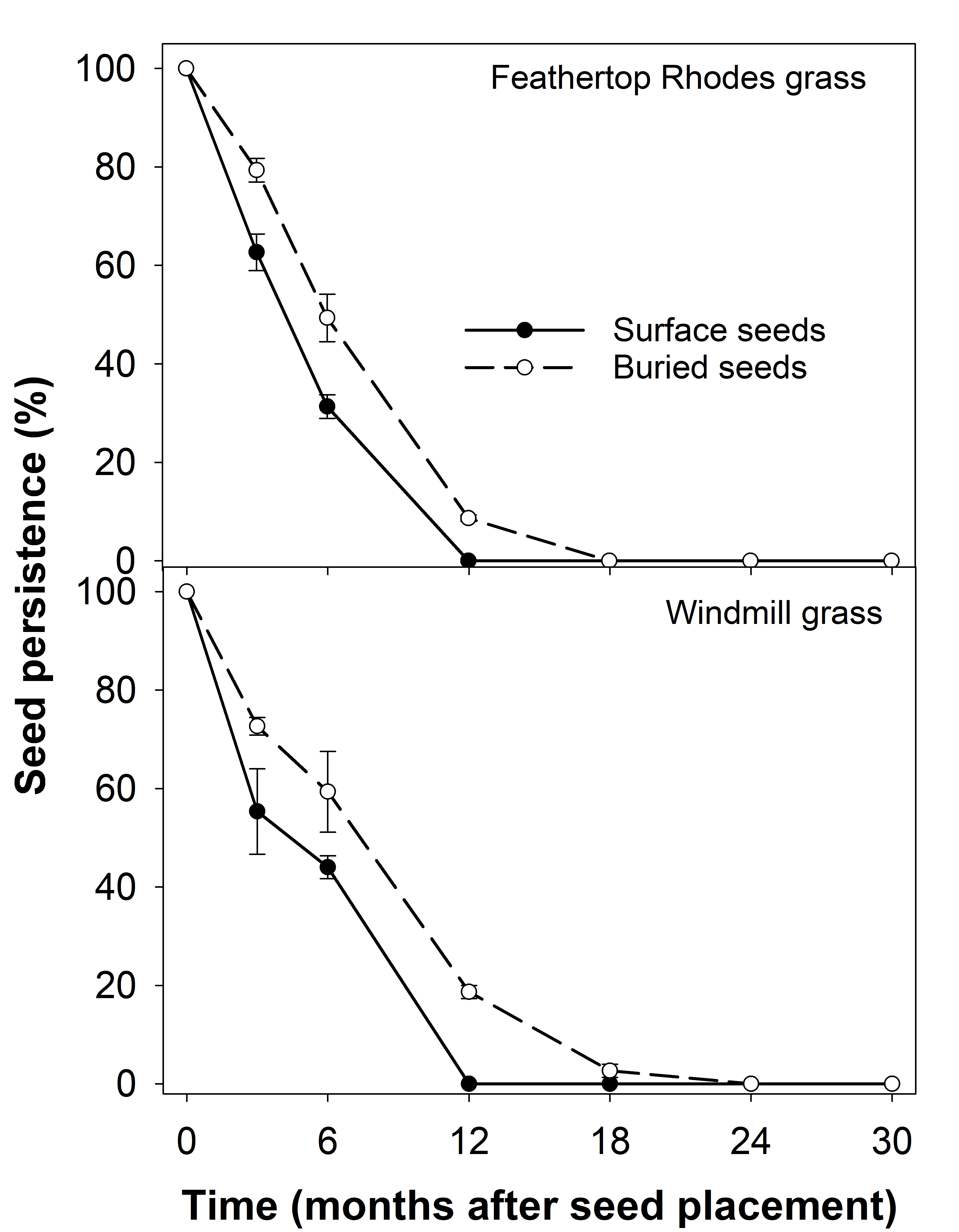Biology of feathertop Rhodes grass and windmill grass
Biology of feathertop Rhodes grass and windmill grass
Author: Bhagirath Chauhan (The University of Queensland) | Date: 01 Jun 2021
Take home message
- Chloris virgata (Feathertop Rhodes grass / FTR) and Chloris truncata (windmill grass / WMG) have become difficult to control weed species in summer crops and fallows
- In Queensland, both species can germinate at temperatures occurring throughout the year
- Greatest germination in both species occurs for surface seeds. Seed burial can inhibit emergence
- FTR is more competitive than WMG
- FTR produces more seeds than WMG; however, it also retains a greater number of seeds than WMG at crop harvest
- Surface seeds of both species were depleted within 12 months, but buried seeds of WMG persisted (24 months) slightly longer than FTR seeds (18 months)
- Integration of crop competition can greatly reduce growth and seed production of FTR.
Introduction
Feathertop Rhodes grass (FTR) and windmill grass (WMG) are increasingly problematic weed species in summer fallows and crops in the northern cropping region of Australia. Both species were considered roadside environmental weeds about two decades ago, but are now also widespread in crop fields. In the northern grain region, FTR has been listed in the top five weeds in terms of causing yield loss and revenue loss (Llewellyn et al. 2016). Both species have developed resistance to glyphosate, a commonly used herbicide in fallows and glyphosate-tolerant cotton. There is a need to develop integrated weed management (IWM) programs to manage these species more effectively. However, knowledge of their biology is a prerequisite for developing sustainable and effective management programs. This paper reviews the biology of FTR and WMG. Where possible, information has been sourced from the northern region. Literature from other regions has also been used.
Temperature effect on germination
Seed germination of WMG was highest (87%) at day/night temperatures of 25/15 °C, but this was similar to the germination at 20/10 and 30/20 °C (Figure 1). More than 65% of WMG seeds germinated at the lowest tested temperature (15/5 °C). A similar study on FTR reported maximum germination (90%) at 30/20°C (Figure 1). About 30% of seeds germinated at the lowest temperature of 17/7 °C.
 Figure 1. Effect of alternating day/night (12 hour/12 hour) temperatures (°C) on seed germination of feathertop Rhodes grass (Fernando et al. 2016) and windmill grass (Chauhan et al. 2018)
Figure 1. Effect of alternating day/night (12 hour/12 hour) temperatures (°C) on seed germination of feathertop Rhodes grass (Fernando et al. 2016) and windmill grass (Chauhan et al. 2018)
A recent study evaluated the effect of alternating day/night temperatures (15/5, 20/10, 25/15, 30/20 and 35/25 °C) on seed germination of eight populations of FTR (Chauhan, unpublished data), where germination varied between the different populations as well as in response to temperature (Figure 2). Some populations had the highest germination at the lowest temperature, 15/5 °C. In a study conducted in South Australia, the base temperature for FTR germination was estimated to be 2 to 3 °C (Ngo et al. 2017). This finding supports results showing that seeds can germinate at temperatures as low as 15/5 °C. The recent data (Figure 2) suggests that our understanding of the germination response of different FTR populations to temperature still needs to be improved.
 Figure 2. Effect of alternating day/night (12 hour/12 hour) temperatures (°C) on seed germination of different populations (shown by different lines) of feathertop Rhodes grass
Figure 2. Effect of alternating day/night (12 hour/12 hour) temperatures (°C) on seed germination of different populations (shown by different lines) of feathertop Rhodes grass
(Chauhan, unpublished data)
Although there were some differences, seeds of FTR and WMG germinated at all tested temperatures, suggesting their ability to germinate throughout the year in Queensland. These predictions are supported by recent observations of FTR and WMG in winter crops and fallows in Queensland.
Burial depth effect on emergence
In South Australia, seedling emergence of FTR was highest (76%) for surface seeds (Figure 3). Only 9% of seedlings emerged from seeds buried at 5 cm. Similarly, the highest seedling emergence (67%) of WMG was observed for seeds placed on the soil surface in a Queensland study. The study reported only 9% emergence of WMG from 2 cm and no emergence from 3 cm.
 Figure 3. Effect of seed burial depth (cm) on seedling emergence of feathertop Rhodes grass
Figure 3. Effect of seed burial depth (cm) on seedling emergence of feathertop Rhodes grass
(Ngo et al. 2017) and windmill grass (Chauhan et al. 2018)
The greatest germination of seeds occurred on the soil surface, suggesting that farming systems that retain most weed seeds on or near the soil surface will promote greater emergence of these weed species. Therefore, tillage operations that bury FTR and WMG seeds below their maximum depth of emergence may be of used as a tool in IWM programs.
Weed density effect on mungbean grain yield
Grain yield of mungbean decreased with increasing competition from FTR and WMG; however, the effect was more severe for FTR than WMG at low weed density (Figure 4). Compared with the weed-free yield (1700 kg/ha), 36 plants/m2 of WMG and 11 plants/m2 of FTR reduced mungbean grain yield by 50%. These results suggest that FTR is more competitive than WMG, and timely management of these species is crucial for minimising yield loss.
 Figure 4. Effect of density (plants/m2) of feathertop Rhodes grass and windmill grass on mungbean grain yield (kg/ha) (Mahajan et al. 2020)
Figure 4. Effect of density (plants/m2) of feathertop Rhodes grass and windmill grass on mungbean grain yield (kg/ha) (Mahajan et al. 2020)
Seed production and seed retention
In mungbean, FTR produced about 230,000 seeds/m2 (Figure 5). At crop harvest, about 97% of these seeds were retained on the plants. WMG produced about 99,000 seeds/m2 and seed retention was 85% at crop harvest. High seed production with wind-mediated seed dispersal contributes to the rapid invasiveness of FTR and WMG. However, a short duration crop such as mungbean can offer an opportunity to capture and destroy seeds of these species at crop harvest. In sorghum, a longer duration crop, seed retention of FTR was 67 to 75% at crop harvest (Mahajan et al. 2020).
 Figure 5. Seed production and seed retention (number/m2) of feathertop Rhodes grass and windmill grass at crop harvest in mungbean (Manalil et al. 2020)
Figure 5. Seed production and seed retention (number/m2) of feathertop Rhodes grass and windmill grass at crop harvest in mungbean (Manalil et al. 2020)
Seed persistence
A study conducted in a dryland environment at Gatton evaluated the effect of burial depth and duration on seed persistence of FTR and WMG. The details are provided in a previous GRDC Update paper. FTR and WMG seeds on the soil surface depleted very fast (Figure 6). No seeds were found viable at 12 months after seed placement. Buried seeds of WMG persisted slightly longer than FTR seeds. About 9% and 20% of buried seeds of FTR and WMG, respectively, were viable at 12 months. No buried seeds were viable at 18 months for FTR and 24 months for WMG. As described above, seeds of both species can germinate at a wide range of temperatures, suggesting that good moisture availability in the first few months after seed shedding may result in the germination of most surface seeds. Seed burial through tillage or high soil disturbance sowing operations (e.g., knife points) may increase the persistence of FTR and WMG seeds in the soil.
 Figure 6. Seed persistence (%) of feathertop Rhodes grass and windmill grass
Figure 6. Seed persistence (%) of feathertop Rhodes grass and windmill grass
(Chauhan and Manalil, unpublished data)
Crop competition effect on weed growth and seed production
There is limited data on the effect of crop competition on comparative growth and seed production of FTR and WMG. In a recent study, FTR was planted in mungbean at 0, 10, 20, 30 and 40 days after crop planting. The crop was sown in 35 and 70 cm rows at 40 seeds/m2. In general, FTR attained greater plant height in 35 cm rows than in 70 cm rows (Table 1). These results suggest that narrow crop rows may make harvest weed seed control practices more feasible by allowing capture of a greater number of weed seeds. FTR also produced lower biomass in the narrow row spacing in comparison to the wider crop rows (Table 1). Only the first two cohorts of FTR produced seeds, and the seed production was lower in the narrow row spacing. Compared with FTR plants emerging with the crop, the second cohort (i.e., 10 days after mungbean planting) produced only 20-25% of seeds, suggesting the importance of early weed control and the relative dates of weed and crop emergence.
Table 1. Plant height, biomass and seed production of feathertop Rhodes grass in mungbean at two different row spacings.
Time FTR was planted | Mungbean row spacing | |
|---|---|---|
35 cm | 70 cm | |
Height (cm) | ||
0 | 90 | 78 |
10 | 70 | 53 |
20 | 42 | 33 |
30 | 35 | 35 |
40 | 26 | 14 |
Biomass (g/plant) | ||
0 | 183 | 374 |
10 | 84 | 154 |
20 | 8 | 25 |
30 | 5 | 10 |
40 | 3 | 7 |
Seed number/plant | ||
0 | 7,900 | 8,800 |
10 | 1,350 | 2,120 |
20 | 0 | 0 |
30 | 0 | 0 |
40 | 0 | 0 |
Another study at Gatton investigated the growth and seed production of FTR in crop-free fallow conditions and also under competition with sorghum sown in 50 cm and 100 cm row spacing at three sorghum and FTR emergence times (early November, December and January) (Mahajan and Chauhan, unpublished data). Seed production of FTR under fallow conditions ranged from 125,000 to 194,000 seeds/plants, with the maximum occurring for plants emerging in November (Table 2). Sorghum competition reduced the seed production of FTR >80% compared to fallow conditions. Narrow row spacing (50 cm) reduced FTR seed production by 58-90% compared with wider row spacing (100 cm), depending on crop and weed emergence dates.
Table 2. Effect of feathertop Rhodes grass emergence time and sorghum competition on its seed production.
Weed & sorghum emergence time | Feathertop Rhodes grass seed production (number/plant) | ||
|---|---|---|---|
Fallow | Sorghum at | Sorghum at | |
Early November | 194,000 | 23,000 | 9,600 |
Early December | 186,000 | 24,000 | 8,200 |
Early January | 125,000 | 19,000 | 1,900 |
Similar to the mungbean study described above, a field study was conducted to evaluate the growth and seed production of FTR following four transplanting times: 0, 14, 28 and 42 days after sorghum emergence (Mahajan et al. 2020). The crop was planted in 1-m rows. FTR produced the greatest height, biomass and seed production for the plants emerging with the crop (Table 3). Allowing the crop to be weed-free for the first 28 days resulted in a 92% reduction in weed biomass and a 94% reduction in weed seed production when compared with the weed plants emerging with the crop.
Table 3. Growth and seed production of feathertop Rhodes grass emerged at different times after sorghum emergence.
Weed emergence time (days after sorghum emergence) | Biomass (g/plant) | Height (cm) | Seed production (no/plant) |
|---|---|---|---|
0 | 28.3 | 200 | 5,740 |
14 | 14.7 | 101 | 5,660 |
28 | 2.4 | 44 | 360 |
42 | 0.4 | 41 | 0 |
These results from different studies demonstrate the importance of crop competition in managing FTR. Planting crops in narrow rows and early weed control could be important components of IWM strategies in summer crops.
References
Chauhan BS, Manalil S, Florentine S and Jha P (2018) Germination ecology of Chloris truncata and its implication for weed management. PLOS ONE 13:e0199949
Fernando N, Humphries T, Florentine SK and Chauhan BS (2016) Factors affecting seed germination of feather fingergrass (Chloris virgata). Weed Science 64:605-612
Llewellyn RS, Ronning D, Ouzman J, Walker S, Mayfield A and Clarke M (2016) Impact of weeds on Australian grain production: the cost of weeds to Australian grain growers and the adoption of weed management and tillage practices. Report for GRDC. CSIRO, Australia. In., 112.
Mahajan G, Walsh M and Chauhan BS (2020) Junglerice (Echinochloa colona) and feather fingergrass (Chloris virgata) seed production and retention at sorghum maturity. Weed Technology 34:272-276
Manalil S, Mobli A and Chauhan BS (2020) Competitiveness of windmill grass (Chloris truncata) and feathertop Rhodes grass (Chloris virgata) in mungbean (Vigna radiata). Crop and Pasture Science 71:916-923
Ngo TD, Boutsalis P, Preston C and Gill G (2017) Growth, development, and seed biology of feather fingergrass (Chloris virgata) in Southern Australia. Weed Science 65:413-425
Acknowledgements
The research undertaken as part of this project is made possible by the significant contributions of growers through both trial cooperation and the support of the GRDC, the author would like to thank them for their continued support.
Contact details
Bhagirath Chauhan (Sunny)
The University of Queensland
Building 8115, Gatton, Queensland 4343
Ph: 0427 923 272
Email: b.chauhan@uq.edu.au
GRDC Project Code: UOA1505-001RTX, UOS1606-001RTX, DPI1912-034RTX,
